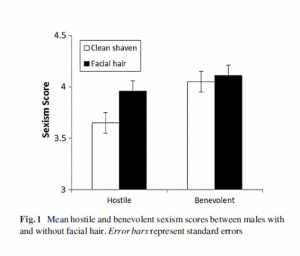Q: This Herald photo caption says “Men with facial hair showed much higher levels of hostile sexism, the study found.” Did it?
A: No.
Q: Ok, how about the introduction “Bearded men will just have to take it on the chin – they are, apparently, more sexist.”?
A: Not really.
Q: <sigh> Was this mice again?
A: No, there aren’t good animal models for these variables, as far as I know. It was people.
Q: University students?
A: No, that’s so five years ago. It was a survey on Amazon’s Mechanical Turk, of men from the US and India.
Q: A representative survey?
A: Well, they paid people US$0.25 to participate, so I’m guessing maybe not. It’s probably better than using an undergraduate psychology class, though.
Q: And they measured sexism and beards over the internet?
A: The sexism was a standard questionnaire, so I think we should accept it. The participants were shown a set of facial hair images and asked to pick what their facial hair looked like. Probably ok, too.
Q: And men with beards were the most sexist?
A: No, men with moustaches, goatees, or soul patches.
Q: Then men with beards?
A: Then ‘light beards’, then light and heavy stubble, then heavy beards, then clean-shaven, then light medium beards.
Q: So it’s not primarily beards, it’s more other sorts of facial hair?
A: That’s what the study suggests
Q: Just like the photo caption?
A: Up to a point. “Much higher” is pushing it.
Q: How much higher?
A: About a third of a point, on a six point scale. About 1.5% of the variation between men could be predicted by their facial hair.
Q: Is there a bar chart, perhaps cut off at some non-zero value?
A: You’ve been reading the Daily Mail, haven’t you? Yes, there is:

Q: That’s not a very big difference, is it?
A: No
Q: So some men with facial hair are probably ok?
A: Probably.
